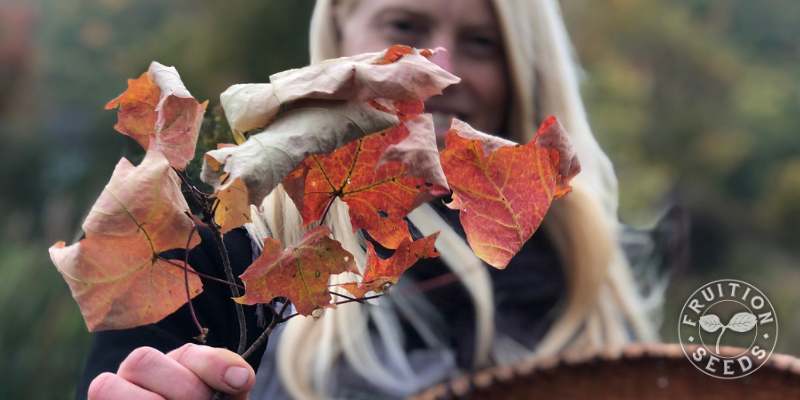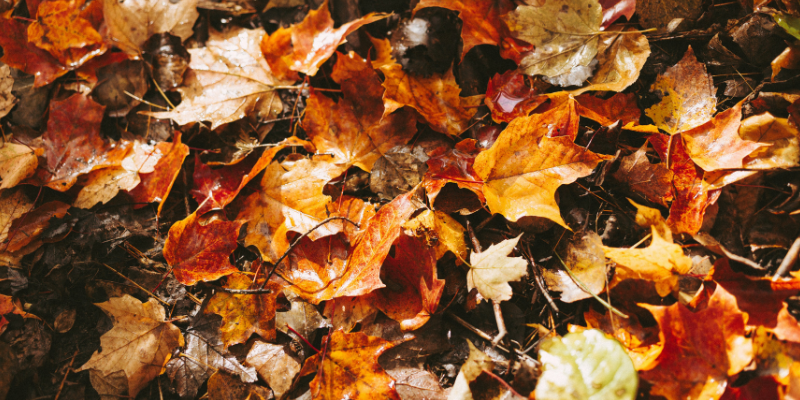‘Tis the season when leaves are falling and streets are lined with ready-made mulch, compost-to-be, nutrient dense and often already bagged for the intrepid gardener to stock up one of the quickest ways to build top-notch soil.
So true!
Here are three keys to maximizing your leaves this fall, to build your soil quickly and mulch most effectively:
1. Deciduous Leaves are the Best for Mulch and Building Soil
Only apply deciduous leaves as mulch in your garden beds. Coniferous pine needles will decompose and acidify your soil, often making the resulting pH less than ideal for growing vegetables, flowers and herbs. If you’re growing blueberries, rhododendrons or want blue hydrangeas, coniferous materials are one of the easiest ways to both mulch and feed them.

2. Chipping/Shredding Your Leaves has the Greatest Impact
Whether you’re building your soil with leaves or spreading them as mulch, send your leaves through a chipper/shredder first. I’ve learned the hard way. Unless they’re broken into smaller bits, your leaves as mulch will form a thick mat preventing a) the soil from warming up in spring and b) your plants from growing up through easily, especially garlic and any perennial flowers. It’s so easy simply to rake the leaves right into your beds, I know! You’ll be wishing you hadn’t when everyone’s rhubarb and asparagus is knee-high and yours has yet to emerge, trust me.
What Size is Best for Leaf Mulch?
Dry leaves will turn into confetti, the dream of the dream, because they have the most comprehensive coverage as mulch and break down most efficiently. Wet leaves will be much more difficult to process and your average piece will be much larger than confetti, though smaller than a leaf. Small twigs will chip/shred easily, but larger pieces are best kept separate. Under three inches in diameter, ‘ramial chips’ are highly prized for their more balanced carbon to nitrogen ratio, compared to trunk wood, and composted they are a serious asset in your soil.
How To Shred Leaves Without A Chipper/Shredder
My friend Will Bonsall, the legendary organic gardening wizard and seed saver of Maine, is a huge lover of leaves and leaf mulch. Though he certainly has a chipper/shredder he is dearly fond of, he shared with me years ago how he has shredded leaves without combustion engines:
– Find a large flat-bottomed vessel, like a garbage can
– Collect deciduous leaves, dry as a bone. If they’re not dry, your mission is impossible.
– With a flat-bottomed shovel, proceed to make noise and slice them until you’re satisfied and ready to mulch.
3. As Mulch, How Much?
– Mulch will condense, losing its loft (and weed-suppression capacity) quickly with its first rain and gradually over time as it decomposes. I’ve found applying closer to eight inches of mulch will meet my needs if I just want six inches of mulch to cover my garlic over the winter.
– Whether you’re mulching garlic, shallots, asparagus or perennial flowers in fall, it’s ideal to spread your mulch just before it rains. The rain will secure your mulch in place, so it’s less likely to blow away.

And What About Wood Chips?
Wood chips, especially from the trunks of trees, are best for mulched paths, which are beautiful and most effective with high-carbon materials. Three to five layers of un-colored cardboard covered in three inches of wood chips is the dream. Though deciduous leaves are relatively high-carbon, they’re better at building soil since they quickly break down, so reserve them for your garden beds either as mulch or soil.
Leaves are the Best
The richness of deciduous leaves is a primary reason we have rich, deep soils here in the Northeast, especially considering they have developed in a blink of a geologic eye in the 15,000 years since the glaciers receded.
As organic gardeners, we are wise to add as many leaves as possible to our soil both as compost and mulch.
May these tips help build your soil and our collective future
Sow Seeds & Sing Songs,

and the Many Beings of Fruition

